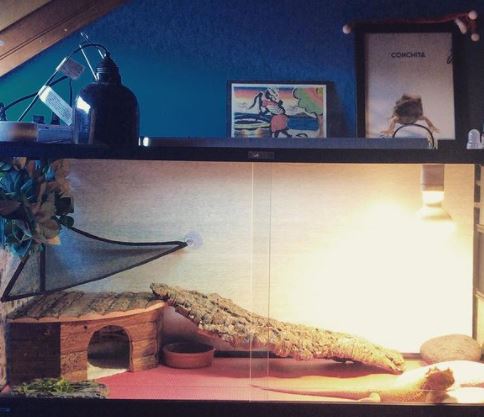Many reptile owners find themselves in a quandary when it comes to where to place the thermometer in the vivarium.
There are pros and cons for both sides, but we will try to break down all of your options so you can make an informed decision.
So, where to place the thermometer in the vivarium?
Related Posts:
- Top 5 Turtle Substrate for Your Pet Tank
- How Long Can a Bearded Dragon Go Without Heat?
- How to Read a High-range Reptile Thermometer?
- Best Reptile Thermometer for Reptiles
- Best Thermometer for Bearded Dragons
Where to Place the Thermometer in the Vivarium?
To make sure your enclosure is maintaining the perfect temperature, you’ll want to place a thermometer on both ends.
If something goes wrong and it’s not reaching where you need for optimal efficiency, then move around until you find what works best.
Where to Place Your Exo Terra Thermometer?
For the best temperature readings, choose a central location for your Exo Terra thermometer to measure.
Do not place in either the coolest or warmest area of the terrarium as this may result in inaccurate readings due to differences between those areas and other more moderate zones, which are closer together around it.
Exo Terra thermometers are designed to measure temperatures in the ideal zone located in the middle of the terrarium.
Avoid placing the thermometer too close to the heater or lamp, fan, ventilation holes/grids, soil surface, or water bowl.
All of these factors may influence the readings and make them less accurate.
The two probes of this thermometer may be placed on the same terrarium or in different locations:
- Place one of them under the substrate and close to a heat source. This will allow you to monitor temperature changes underneath the hot spot.
- Keep the other next to your basking site, e.g. inside a shelter, cave, or on top of a branch, to monitor the body temperature of your reptile.
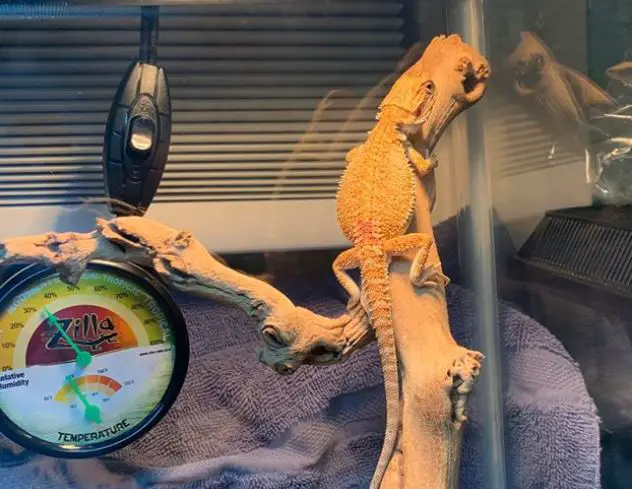
How to Take Accurate Temperature Readings in a Vivarium?
To take accurate temperature readings in a vivarium, use multiple thermometers.
Always make sure to use a digital probe with a remote sensor outside the cage.
Make sure that there is no electrical equipment such as power banks, hairdryers, and microwaves near the vivarium while readings are being taken or recorded.
These appliances can create heat or humidity within the enclosure, which can lead to inaccurate readings.
What Factors Might Affect the Accuracy of Thermometers?
Placing or removing objects near or around the thermometer, such as branches and plants, might affect its accuracy.
The way in which the operator opens and closes the cage is also a factor.
For instance, if a cage is opened with force or mishandled, there’s a high probability that elements of the habitat inside might be jostled around and this could lead to inaccurate readings.
When to Replace the Probe of the Digital Thermometer?
Replace probes at least once a year and whenever temperature and humidity readings are found to be way off target.
Manufacturers usually give recommendations on how often you should change the probe, so follow their guidelines for the best results.
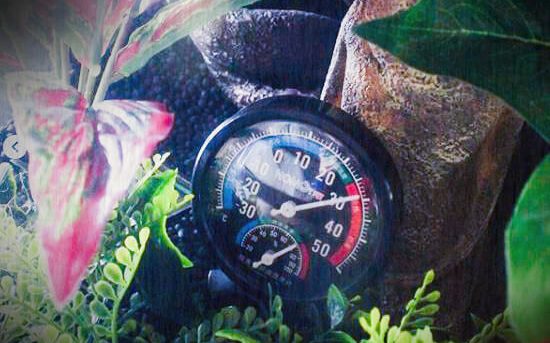
Where to Put the Thermometer in the Crested Gecko Tank?
One of the most common questions we have been getting is where to put a thermometer in a crested gecko tank.
You need to find out if your little guy or gal likes it hot or cool for proper temperature.
The best way to do this is with a digital thermometer with a remote probe (the kind they use to check meat in ovens).
You then stick the probe into the substrate where your gecko hangs out most of the time.
For example, if he likes to be on the warm side, you put the probe in the area where he sleeps. If he likes it cool, you put it near a cooler end of his tank.
You can also use a non-remote temp gun if you want to take readings from multiple locations within the tank and don’t mind moving them around often.
This will give you an accurate reading of the temperature but is not as easy to move around as the remote probe.
Readings will change on their own depending on where they are in the tank, so take new readings multiple times a day for several days (or until you get good data) if you want to know what your gecko prefers.
How to Know What Temperature Your Gecko Prefers?
You can put them on opposite ends of the tank and watch the temperature gradient, then you will know what your gecko prefers: hot or cool.
If it’s close to one end of the tank (say within 5 degrees), it’is safe to say that that is its preferred temperature zone.
If there is a large spread (more than 10 degrees), you may need to get a better understanding of what temperature your gecko likes.
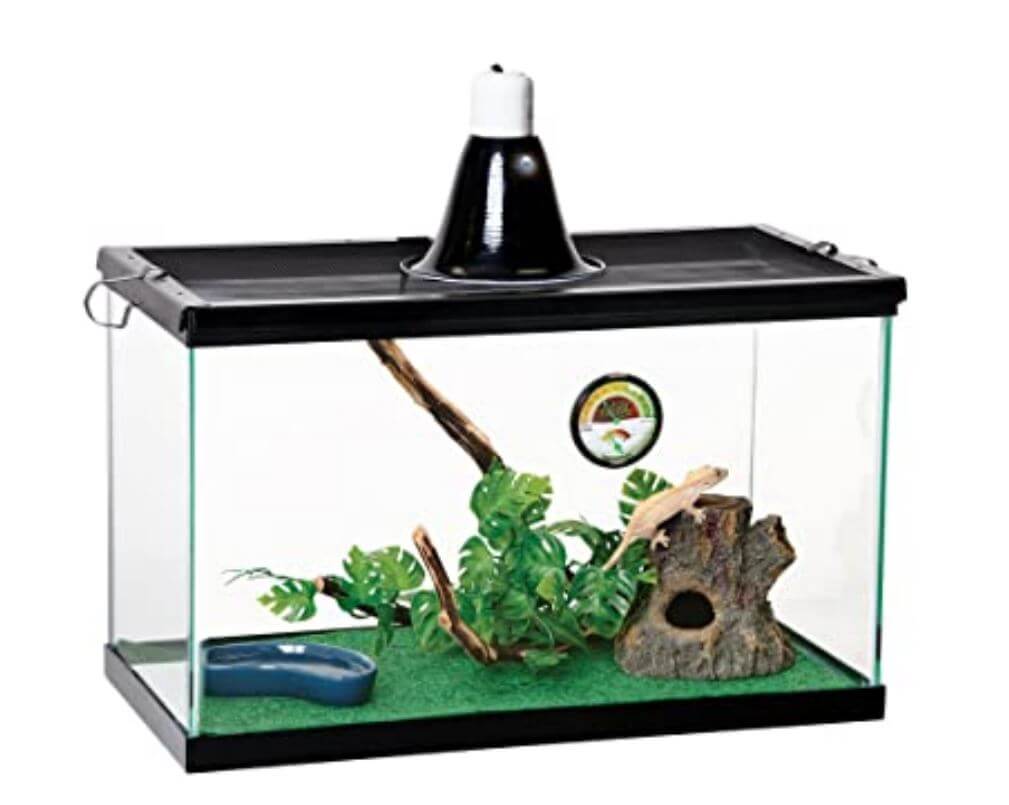
How to Choose to Right Light Color for Your Gecko?
Your gecko’s eyes may have a greater sensitivity to different wavelengths.
Don’t be surprised if one color gives better results than another. For example, a red night light might be preferred over a blue night light.
Red has been known to mimic an approaching sunrise and thus arouse crested geckos from slumber to bask in the warmth of this simulated sunrise.
You can also try putting a heating pad under part of the tank if you want it warmer.
This will help warm up one end of the tank (should be all you need) and doubling the wattage on your night light bulb should give you enough heat as well.
If you have a basking spot, try using a 25- to 50-watt bulb as the only source of light in the tank during daylight hours.
You can also use any reptile night light, but those with red bulbs seem to be preferred by most geckos because they look more like sunset to them.
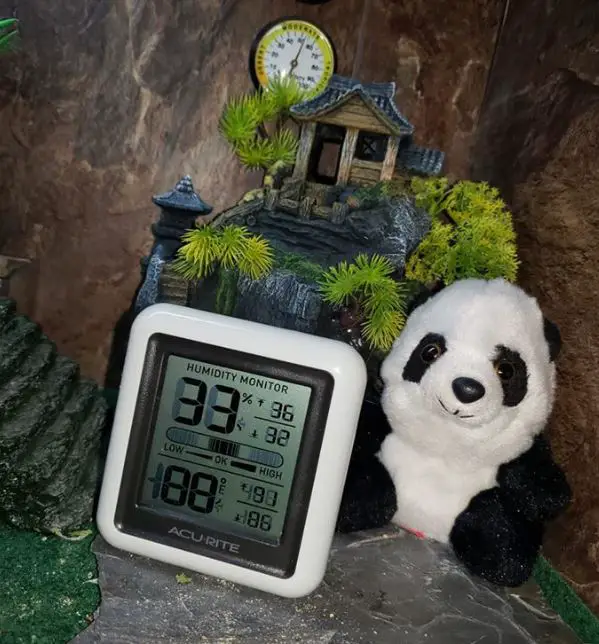
Where to Put the Thermometer in a Bearded Dragon Cage?
Bearded dragons are curious, active creatures that require a lot of room to roam around.
As they are diurnal lizards, this means they are awake during the day and sleep at night. This needs to be taken into consideration when setting up their ideal habitat.
The best place for the thermometer in a bearded dragon cage is on one of the upper walls, as this is where they will be basking most of the day.
We recommend putting two thermometers in the terrarium. One at the end where it is hot, and one at the other end where it is cooler.
Place the thermometer near where your bearded dragon spends most of his time.
Conclusion
Place the thermometer in a location where it will be out of reach to animals, but also not too high or low. This way, you can get an accurate reading without worrying about any animal interference.
Key take away points when it comes to where best to position the thermometer within the vivarium:
Proper thermometer placement in a vivarium is crucial for monitoring temperature and ensuring the well-being of your reptiles. Here are key considerations and guidelines for where to place the thermometer:
1. Temperature Zones:
- Different reptile species have specific temperature requirements. Identify the warm and cool zones within the vivarium to determine where to place thermometers.
2. Basking Spot:
- Position a thermometer near the basking area, which is the warmest part of the enclosure. This ensures you can monitor the temperature where your reptile thermoregulates.
3. Cool Side:
- Place a thermometer on the cooler side of the vivarium to track the lower temperature range. This helps provide a temperature gradient for your reptile.
4. Substrate Level:
- Mount a thermometer near substrate level to measure the temperature your reptile experiences at ground level.
5. Avoid Direct Heat Sources:
- Do not place a thermometer directly on or too close to heat sources, such as heat lamps or heat pads, as this can result in inaccurate readings.
6. Ventilation and Shading:
- Keep thermometers away from direct airflow or shaded areas within the vivarium to prevent skewed temperature readings.
7. Ensure Visibility:
- Position the thermometer where you can easily read it without disturbing the enclosure. This helps you monitor temperatures without frequent disturbances.
8. Digital vs. Analog:
- Choose between digital and analog thermometers based on personal preference and accuracy requirements. Digital thermometers are often more precise.
9. Multiple Thermometers:
- Depending on the vivarium’s size and complexity, consider using multiple thermometers to monitor various zones effectively.
10. Hygrometer Placement: – If monitoring humidity is important, consider combining a thermometer with a hygrometer to track both temperature and humidity.
11. Calibration: – Regularly calibrate your thermometers to ensure accuracy. Some models may require adjustment or recalibration.
12. Avoid Substrate Contact: – Prevent the thermometer from touching the substrate or enclosure walls, as this can influence temperature readings.
13. Check for Dead Zones: – Periodically assess your vivarium for temperature “dead zones” where air circulation may be inadequate. Place a thermometer in such areas to ensure your reptile’s comfort.
14. Monitoring at Different Times: – Check temperature readings at various times throughout the day and night to understand the vivarium’s temperature fluctuations.
15. Consistency is Key: – Maintain a consistent thermometer placement within the vivarium to ensure that temperature monitoring is reliable.
16. Regular Inspections: – Frequently inspect and clean the thermometer to prevent dust or dirt from affecting its accuracy.
17. Backup Thermometers: – Consider using backup thermometers or probes to cross-verify temperature measurements for added reliability.
In summary, the placement of thermometers in a vivarium is critical for maintaining the ideal temperature gradient for your reptiles. By strategically positioning thermometers in the warm, cool, and ground-level areas, you can effectively monitor temperature variations and ensure the comfort and well-being of your beloved pets. Remember to regularly inspect and calibrate thermometers to maintain accurate readings.
Further Reading:
- Best Thermometer for Bearded Dragon
- Bearded Dragon Body Language: How to Figure Out?
- 8+ Bearded Dragon Dying Signs You Need to Know
- Can a Bearded Dragon Survive Outside?

